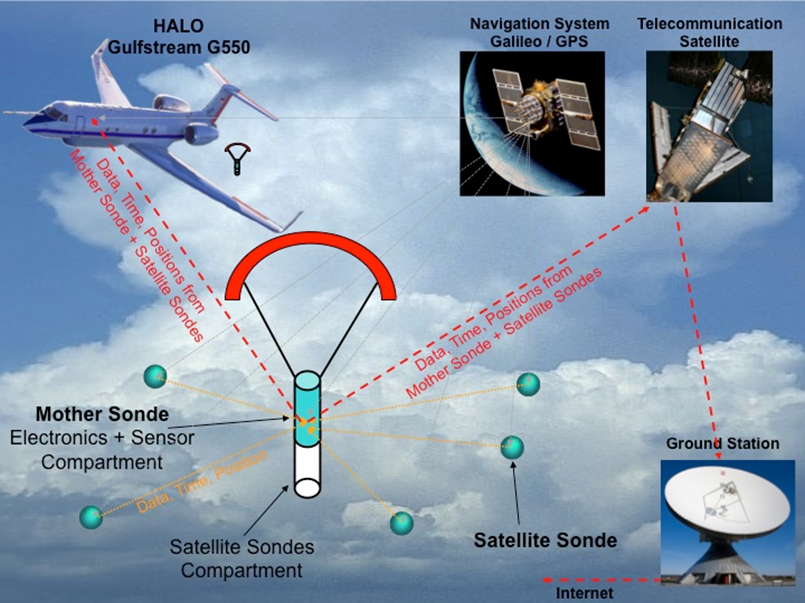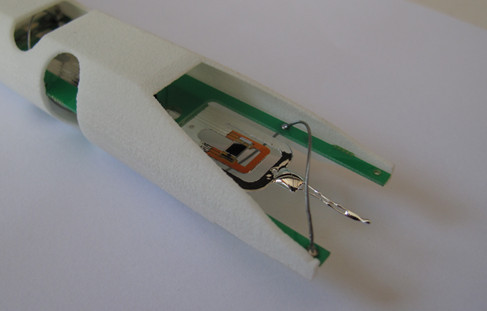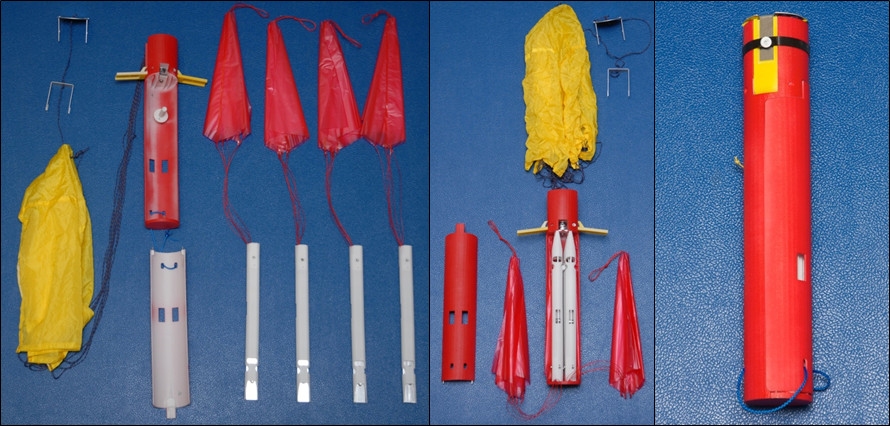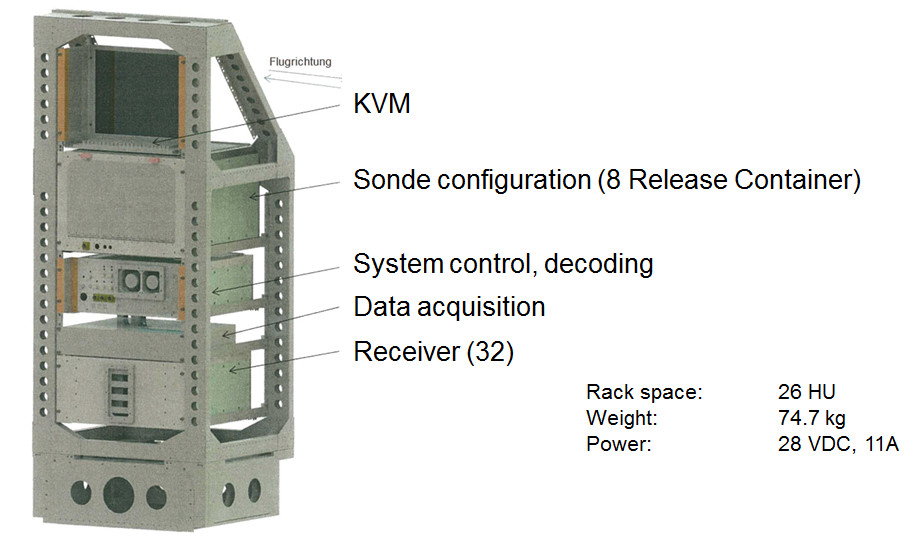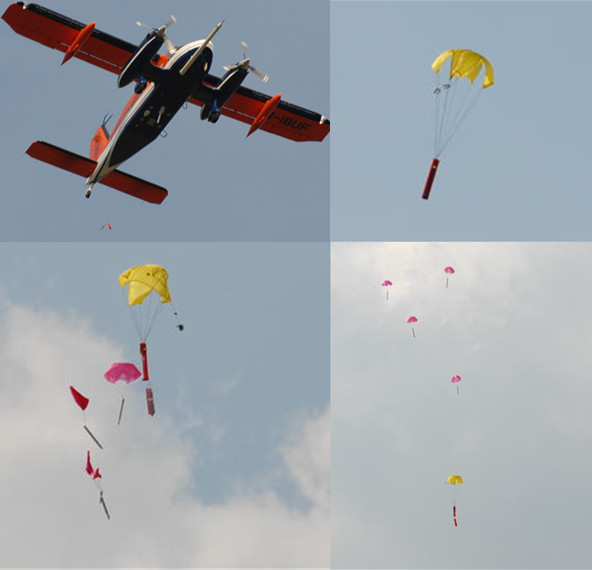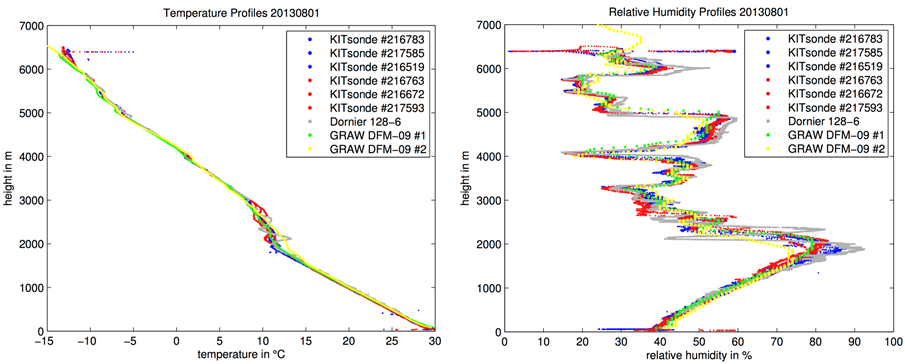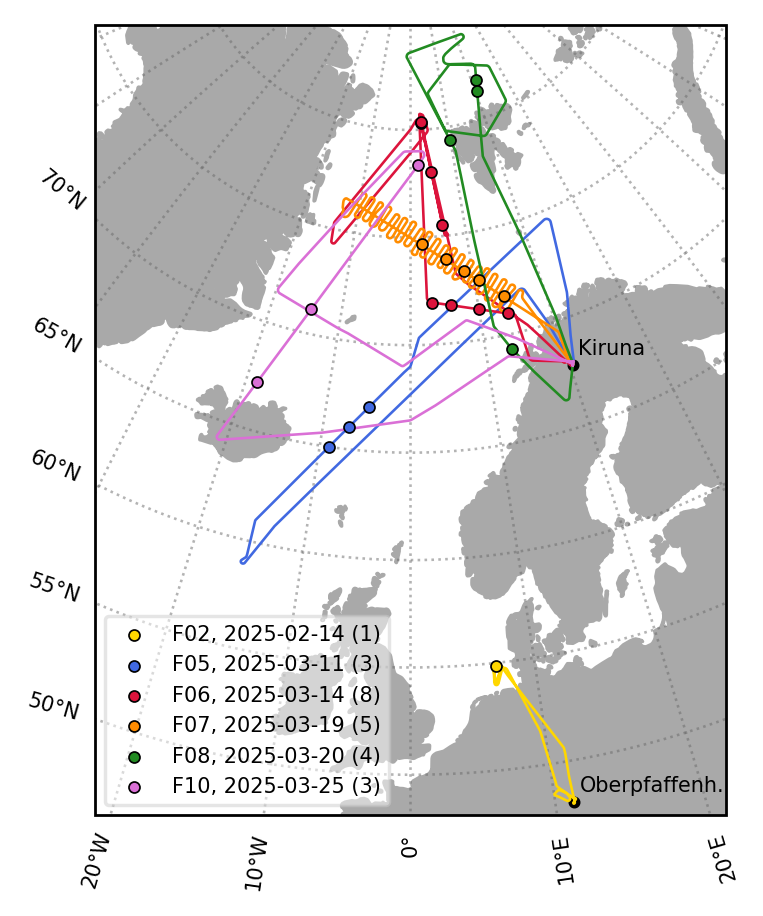KITsonde
Introduction
IMK-TRO developed a new multi-sensor dropsonde system "KITsonde" for high and fast-flying research aircraft such as HALO (Fig. 1). The modular design of KITsonde combines the strengths of existing dropsonde systems, such as the widespread AVAPS (Airborne Vertical Atmospheric Profiling System) and the Karlsruhe dropsonde. With the new system, up to 30 sondes can be used simultaneously. This enables spatially and temporally high resolved measurements in the region of inhomogeneous zones of the atmosphere, such as convective cells or cyclones. A separation of sondes and release containers allows the drop of up to four sondes at the same time and the easy integration of new sensor technologies. In the first phase of airdrop, the sondes are decelerated safely protected in the release container.
In the basic version, KITsonde provides profile measurements of pressure, humidity, temperature and wind. The resolution is adjusted to get a better understanding of the processes involved in the development of the above named weather phenomena. This data can be made available worldwide immediately if necessary through a direct satellite link to the sonde. KITsonde ultimately lead to an improved predictability of occurrence and development of extreme weather situations. After an initial test phase in spring of 2012, further test flights with the Dornier Do-128 IBUF took place in August 2013. The KITsonde was in operation on the research aircraft HALO for the SouthTRAC campaign 2019, for the ASCCI mission 2025, and will be an important part of the NAWDIC campaign 2025/2026.
In the development of this novel measurement system the IMK-TRO worked along with two industrial partners. GRAW Radio Sondes GmbH & Co. KG, Nürnberg developed and produce the meteorological measuring probe, which is comparable to the latest radiosonde generation DFM-09. The enviscope GmbH, Frankfurt / M. is responsible for discharge containers, aircraft fittings, control software, and certification of the system.
KITsonde design goals
- High resolution measurements with up to 30 sondes
- Launch of up to 4 sondes at the same time
- Direct telemetry link to the aircraft (400 MHz)
- Satellite telemetry as optional data link (Iridium)
- Compatible to widely-used launching systems
- Economically priced and modular design
- Easy adaption to future sensor developments
- Free combinations of sondes and sensors
KITsonde development
The system consists of three major parts:
- Meteorological sonde (Fig. 2, Fig. 3)
- Multipurpose release container (Fig. 4)
- Aircraft receiver and data acquisition units (Fig. 5)
The dimension of the release container is compatible to the widespread AVAPS which makes KITsonde easily adaptable to a wide variety of research aircraft. Using the release container different sensors can be deployed at the same time. New sensor developments can be integrated with minimum efforts since the release container protects its payload from mechanical load during the release (Fig. 6). Future probes could include sensors for liquid water, particles (aerosol, droplets), volcanic ash and radioactivity. During test flights in August 2013 sensors for particles from the University of Hertfordshire were successfully installed and tested (Ulanowski et al., DUST 2014).
The standard meteorological sonde is equivalent to the DFM-09 Radiosonde by GRAW Radiosondes. Features of the dropsonde use are:
- 400 MHz transmitter frequency stabilization
- 400 MHz transmitter output stage switch (jumper)
- New power switch mechanism
- Transmission of time and sonde ID
- Interface for additional external sensors
- Data link for satellite modem interface
- Software for initialization, decoding and calibration
Specifications of the meteorological sonde
| Temperature sensor: | Thermistor |
| Temperature resolution: | 0.1 K |
| Temperature accuracy: | < 0.2 K |
| Humidity sensor: | Thin film capacitive sensor |
| Humidity resolution: | 0.1 % relative humidity |
| Humidity accuracy: | < 5 % relative humidity |
| Geopotential height accuracy: | < 10 m |
| Wind speed accuracy: | < 0.2 m s-1 |
| Position accuracy (horizontal): | < 5 m |
| Size, Weight: | 309 x 24 mm , 75 g |
The aircraft receiver is based on Superhet design which provides best performance, small size, and low power consumption. The receiver unit includes 32 receivers: one for frequency band scanning, one for sonde prelaunch test and 30 to receive data streams from active sondes. Data acquisition features real-time data decoding and storage. The system can be operated by only one user. Configuration and real time data visualization is provided by a GUI accessible at the aircraft rack or via network on any computer aboard the aircraft (Fig. 5). The receiver box design allows the use of AVAPS next to KITsonde.
Operation and data quality
Test flights with the release container and a basic KITsonde system were successful. Multiple flights and launches have been performed and measurement data was analyzed and compared to different radiosondes (DFM-06, DFM-09, Vaisala RS92, Karlsruhe Dropsonde) and aircraft in situ measurements of Dornier 128 D-IBUF of TU Braunschweig (Fig. 7). Laboratory and field testing proved the good data quality of the new sonde. Furthermore, KITsonde was operated on the HALO research aircraft during the SouthTRAC campaign and the ASCCI mission (Fig. 8, 9).
More Informationen
Kottmeier, C., Wieser, A., Corsmeier, U., Kalthoff, N., Gasch, P., Kirsch, B., Ebert, D., Ulanowski, Z., Schell, D., Franke, H., Schmidmer, F., Frielingsdorf, J., Feuerle, T., and Hankers, R.: A New Versatile Dropsonde for Atmospheric Soundings with HALO – The KITsonde, EGUsphere [preprint], https://doi.org/10.5194/egusphere-2024-2817, 2024.

